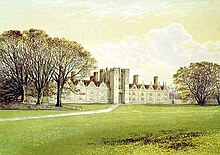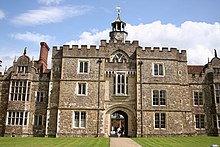Knole House
Knole House [ noʊl haʊz ] is a cultural monument of Category Grade I classified mansion in the Jacobean style on the outskirts of Sevenoaks in the northwest of the county Kent in England . What is remarkable is the largely unchanged state of preservation of the property and its rooms since the early 17th century.
history
Knole is first mentioned in documents from Lambeth Palace in 1281 . The location on a hill (Engl. Knoll ) to the estate have given his name. The manor was given to Geoffrey, Lord de Say , whose grandson was named Lord Say and Sele in 1447 . His son William Fiennes sold the property in 1456 to Thomas Bourchier , Archbishop of Canterbury . He had the house expanded into a fortified, two-story palace between 1456 and 1486. The building is said to have been a strict, fortress-like structure around an inner courtyard and to have had a large hall, a large chamber and a tower-reinforced gatehouse. The adjoining wildlife park was established from 1465. Knole remained in the possession of the archbishops until 1538, when Henry VIII had the house given to him by Archbishop Thomas Cranmer . The king had Knole expanded from 1543 to accommodate his entourage. The Green Court complex with the three-storey gate tower dates from this era . In 1561, Elisabeth I wanted to transfer Knole to the Earl of Leicester , who refused the estate, whereupon Elisabeth Knole gave it to her cousin Thomas Sackville, 1st Earl of Dorset, in 1566 . He had the house expanded considerably from 1605 to 1608. Knole remained in the family ownership of the Sackvilles for over 400 years, who became Dukes of Dorset in 1720 . After the 4th Duke's death in 1815, the castle was inherited by his sister Elizabeth, who was married to George West, 5th Earl De La Warr. Her younger descendants received the title of Baron Sackville . The writer Vita Sackville-West was born in Knole. In 1945, the fourth Lord Sackville gave the house and garden as well as the adjoining, approximately ten hectare garden to the National Trust . The Sackville family has perpetual right of residence as sub-tenants in one part of the house. The actual park is still privately owned.
Parts of the mansion can be visited from April to October. In 2012, an extensive restoration of the house began, which is one of the largest projects of the National Trust.
investment
Knole House is located on a plateau in the middle of the wildlife park, offering views over the park and the surrounding Kent and North Downs countryside . The extensive complex has 365 rooms like the year days, 52 stairs like the year weeks and seven courtyards like the week days, making it a so-called “calendar house”.
The entrance through the gate tower in the north-western main facade leads into the lawn-covered Green Court, which was laid out in the 16th century. Behind the courtyard is the original palace from the 15th century, the core of which is the medieval manor house. The mansion, which is built around two inner courtyards, is largely made of pebble sandstone , only the upper floors of the east wing are made of plastered half-timbering. During the renovation by Thomas Sackville, the building received a new roof and the addition of stables to the north of the Green Court, while the state apartments were set up in the south wing. In 1823 the orangery was built on the south-west corner of the Green Court.
Interior decoration
The halls and rooms have magnificent carvings, stucco ceilings, tapestries and the world's most complete collection of Stuart period furniture . Several rooms are fully furnished with chairs, stools and tables from Whitehall Palace and Hampton Court Palace . The painting collection includes paintings by van Dyck , Thomas Gainsborough , Peter Lely and Godfrey Kneller . The Reynolds Room contains a collection of over ten paintings by Joshua Reynolds .
Among the most magnificent rooms that can be visited are
- the entrance hall with a carved rood screen with a singing gallery
- the Leicester Gallery, with its early 17th century armchairs and the Knole sofa with adjustable armrests
- The bedroom of the Venetian ambassador with the gilded four-poster bed made for James II
- The king's bedroom with another four-poster bed with gold and silver-woven curtains and furniture from the last quarter of the 17th century decorated with pure silver and gold brocade.
- The ballroom with the portrait gallery of the Sackvilles
garden
To the south and east, the manor house is surrounded by a garden of over ten hectares, which is surrounded by a wall built in the 16th century. The western half was formally laid out in the 18th century with parterre and gravel paths, the eastern half is densely covered with trees. About 250 meters to the south-east is the walled kitchen garden with a gardener's house , which was first shown on a map in 1769 .
park
The house and garden are enclosed on all sides by the extensive 378 hectare park. The park is located in gently undulating terrain that rises from northwest to southeast and consists of open woodland and meadows with individual groups of trees. It has been used as a wildlife park since 1465 and was given its current size and shape in 1826. It is bordered by avenues in the northeast and southwest, and a stone wall from the 19th century is added to the northeast. The golf course, which was laid out in 1923, stretches from the tree-lined Echo Mount in the northeast to the kitchen garden in the south. The park is considered a Site of Special Scientific Interest , since the 15th century a herd of around 500 fallow deer has lived in it today.
Knole House in Literature and Film
Vita Sackville-West described Knole House in her work Knole and the Sackvilles , published in 1922. When her father died in 1928, she was not allowed to inherit the property as male inheritance occurred. Vita Sackville-West never got over this loss, and even the purchase of Sissinghurst Castle , which she and her husband Harold Nicolson made in 1930, was only a small consolation.
Her friend Virginia Woolf took the history of the house and the Sackville family as a basis in her biography Orlando . The original Orlando manuscript is on display at Knole House .
The mansion has served as a film set several times, including in the English historical drama The Queen's Sister . In January 1967 the Beatles shot promotional films in the park for their songs Strawberry Fields Forever and Penny Lane , which are counted among the first music videos .
literature
- Vita Sackville-West: Knole and the Sackvilles , 1922 (Drummond, London 1948)
- Virginia Woolf: Orlando . Hogarth Press, London, 1928 - Orlando - a biography . Fischer, Frankfurt a. M. 1992, ISBN 3-596-11331-8
Web links
- National Trust: Knole
Individual evidence
- ↑ English Heritage: Knole. (No longer available online.) Formerly in the original ; Retrieved March 7, 2012 . ( Page no longer available , search in web archives ) Info: The link was automatically marked as defective. Please check the link according to the instructions and then remove this notice.
- ↑ BBC News: National Trust launches appeal to save Knole House. Retrieved March 8, 2012 .
- ^ Knole Park Golf Club: History. Retrieved March 7, 2012 .
- ↑ Exploring LGBTQ history at Knole , nationaltrust.org, accessed December 18, 2019
- ↑ filme-schauspieler.de: Knole. Retrieved March 8, 2012 .
- ↑ songfacts: Strawberry Fields forever. Retrieved March 8, 2012 .
Coordinates: 51 ° 15 ′ 58 ″ N , 0 ° 12 ′ 20 ″ E




